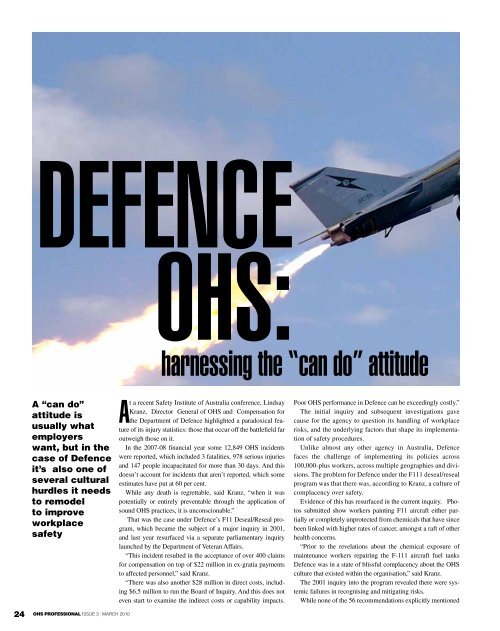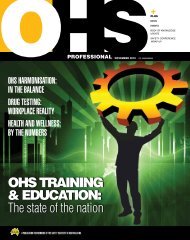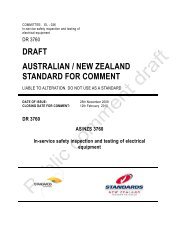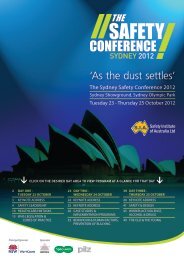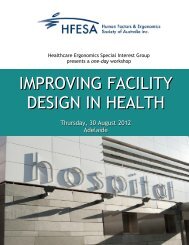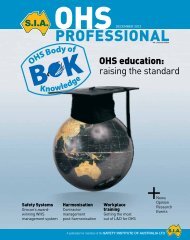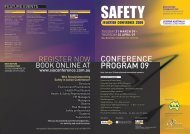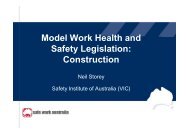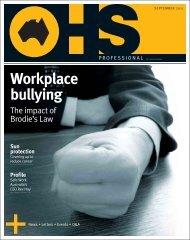Defence: overcoming its âcan Doâ culture unsW kills safety anD risk ...
Defence: overcoming its âcan Doâ culture unsW kills safety anD risk ...
Defence: overcoming its âcan Doâ culture unsW kills safety anD risk ...
Create successful ePaper yourself
Turn your PDF publications into a flip-book with our unique Google optimized e-Paper software.
<strong>Defence</strong>ohs:harnessing the “can do” attitude24a “can do”attitude isusually whatemployerswant, but in thecase of <strong>Defence</strong>it’s also one ofseveral culturalhurdles it needsto remodelto improveworkplace<strong>safety</strong>OHS PrOfeSSiOnaL ISSUE 3 | MARCH 2010at a recent Safety Institute of Australia conference, LindsayKranz, Director General of OHS and Compensation forthe Department of <strong>Defence</strong> highlighted a paradoxical featureof <strong>its</strong> injury statistics: those that occur off the battlefield faroutweigh those on it.In the 2007-08 financial year some 12,849 OHS incidentswere reported, which included 3 fatalities, 978 serious injuriesand 147 people incapacitated for more than 30 days. And thisdoesn’t account for incidents that aren’t reported, which someestimates have put at 60 per cent.While any death is regrettable, said Kranz, “when it waspotentially or entirely preventable through the application ofsound OHS practices, it is unconscionable.”That was the case under <strong>Defence</strong>’s F11 Deseal/Reseal program,which became the subject of a major inquiry in 2001,and last year resurfaced via a separate parliamentary inquirylaunched by the Department of Veteran Affairs.“This incident resulted in the acceptance of over 400 claimsfor compensation on top of $22 million in ex-gratia paymentsto affected personnel,” said Kranz.“There was also another $28 million in direct costs, including$6.5 million to run the Board of Inquiry. And this does noteven start to examine the indirect costs or capability impacts.Poor OHS performance in <strong>Defence</strong> can be exceedingly costly.”The initial inquiry and subsequent investigations gavecause for the agency to question <strong>its</strong> handling of workplace<strong>risk</strong>s, and the underlying factors that shape <strong>its</strong> implementationof <strong>safety</strong> procedures.Unlike almost any other agency in Australia, <strong>Defence</strong>faces the challenge of implementing <strong>its</strong> policies across100,000-plus workers, across multiple geographies and divisions.The problem for <strong>Defence</strong> under the F111 deseal/resealprogram was that there was, according to Kranz, a <strong>culture</strong> ofcomplacency over <strong>safety</strong>.Evidence of this has resurfaced in the current inquiry. Photossubmitted show workers painting F11 aircraft either partiallyor completely unprotected from chemicals that have sincebeen linked with higher rates of cancer, amongst a raft of otherhealth concerns.“Prior to the revelations about the chemical exposure ofmaintenance workers repairing the F-111 aircraft fuel tanks<strong>Defence</strong> was in a state of blissful complacency about the OHS<strong>culture</strong> that existed within the organisation,” said Kranz.The 2001 inquiry into the program revealed there were systemicfailures in recognising and mitigating <strong>risk</strong>s.While none of the 56 recommendations explicitly mentioned


